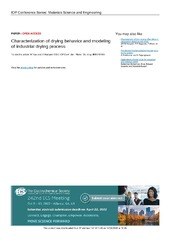Приказ основних података о документу
Characterization of drying behavior and modeling of industrial drying process
| dc.creator | Vasić, Miloš | |
| dc.creator | Radojević, Zagorka | |
| dc.date.accessioned | 2022-04-18T15:22:17Z | |
| dc.date.available | 2022-04-18T15:22:17Z | |
| dc.date.issued | 2020 | |
| dc.identifier.issn | 1757-8981 | |
| dc.identifier.uri | http://rims.institutims.rs/handle/123456789/389 | |
| dc.description.abstract | The general method for industrial chamber dryer optimization was reported in this paper. The first step in finding the most suitable drying regime is to characterized the clay raw material, especially its water loss at 2000C and to determine the critical drying rate inside the specially constructed laboratory dryer. These data provides us information if the product or the dryer is the bottleneck for the optimisation. If the optimization is justified geometry of the dryer, air mass flows, temperature, and humidity profiles inside the dryer as well as initial water content in the drying material, initial temperature of the products and the load of the dryer are required. Some of the previously mentioned data are only used to check if the chamber dryer is working properly, while the others are used as the initial parameters necessary for software simulation. In this paper two models for calculating the optimal drying parameters were used. The first model was developed from the comprehensive theory of the moisture migration during isothermal drying. The calculation software for setting up the non - isothermal drying regimes was reported in our previous papers. It is important to say that this model was not able to adequately predict the temperature raise within the drying products. In order to simulate the raise of the temperature of the roofing tiles during drying the second model was used. This simple receding drying front model was firstly reported by Kitcher. If both models are used simultaneously it is possible to calculate air temperatures, product temperature, absolute and relative humidity of the drying air, moisture content of the product, drying rate etc ... It is important to mention that this approach can lead to the recommendations for changes inside the dryer before an optimized situation is achieved. One example of such situations is described in this paper in details. | en |
| dc.publisher | IOP Publishing Ltd, Bristol | |
| dc.relation | info:eu-repo/grantAgreement/MESTD/inst-2020/200012/RS// | |
| dc.rights | openAccess | |
| dc.rights.uri | https://creativecommons.org/licenses/by/4.0/ | |
| dc.source | International Conference on Modern Technologies in Industrial Engineering ModTech 2020 | |
| dc.subject | drying behavior | |
| dc.subject | industrial drying process | |
| dc.title | Characterization of drying behavior and modeling of industrial drying process | en |
| dc.type | conferenceObject | |
| dc.rights.license | BY | |
| dc.citation.other | 916: - | |
| dc.citation.volume | 916 | |
| dc.identifier.doi | 10.1088/1757-899X/916/1/012124 | |
| dc.identifier.fulltext | http://rims.institutims.rs/bitstream/id/243/386.pdf | |
| dc.identifier.scopus | 2-s2.0-85093646180 | |
| dc.identifier.wos | 000625330000124 | |
| dc.type.version | publishedVersion |

